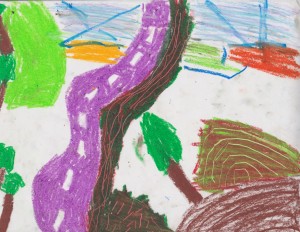“We just had the greatest class discussion! The vocabulary, the ideas, the connections…BUT, when it came to writing it down, they fell apart.” Does this sound familiar? We’ve all seen how easy it is to lose the magic when they face the blank page. How we handle the delicate transition to writing is the key to getting students to transfer their spoken language to the paper.
We often over-structure this transition, offering sentence starters and writing prompts which only serve to limit the children. Just as often, we give too much freedom, trusting that their enthusiasm for the painting will spill onto their paper. Both approaches usually result in blank pages. Offering the right balance of support is key. Here are two steps that ease the path to writing:
1. Allow time for drawing. With limited time in our schedules, I know it is tempting to jump to the writing. But I can’t overstate the value of taking the time to draw first. Drawing helps them – and us – see what they want to say. After discussing a painting, ask them to copy all or part of it, or they can draw something that the painting made them think of from their own lives. This helps them find their own writing voices.
Below, a third grade student has copied a painting from a postcard.


2. Provide Writing Invitations. These are key to helping students transfer their ideas to writing. Below are some Writing Invitations that I have used to guide students, while still allowing them enough choice to use their own voices. I always give at least two invitations, and I always “Your choice” (the child who chooses that one has thought of something I haven’t – and I am usually pleasantly surprised).
Sample Writing Invitations:
– Imagine yourself into your picture. What happens around you? Use all your senses to write a description or a story. (Other ways to say this: “Press play as if this painting is a video. What happens when it starts?” Or, “Start by telling what you smell, hear, see, or feel. Be detailed so I can imagine exactly what it’s like.”)
– Describe this painting. Be as detailed and descriptive as you can, and surprise me. (This is where metaphors and similes begin to show up).
– Write about what you were thinking as you drew. Where did your mind take you? What did you wonder and notice? What was easy or hard about drawing this picture? What surprised you?
– (for masks, statues, or portraits) Can you become this person for a while and write about your day?
– Does this picture/art piece make you think of a real place you’ve been, or a moment in your life? Include the sounds, the smells, the feeling of your memory.
– Your choice
There are unlimited Writing Invitations. You will think of what fits the needs of your class. For young children, sentence starters are not the enemy! Giving them the first few words can kick-start things for them (stick to something open-ended such as “I see/smell/feel/hear….” rather than something more constraining like, “I like this painting because…”).
After copying Hockney’s painting, this third grader reacted to the second invitation from above. She wrote:
“There is a squiggly purple road heading south. On the left there is a crowded tree place with one humpy hill. On the right of the road there is a grassy place with a garden. Down south the road leads to a rural kind of place which looks like precious glass.”
For teachers: Copy a painting into your journal, and use an invitation to write about it. What was your process like? What was surprising? Share your experience with your class – and with us!
Love it, Darcy… Lots of tangible ideas for teachers and students alike.